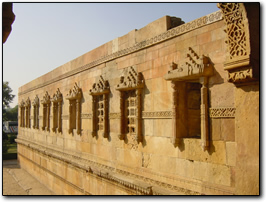Ajanta, Surat & Champaner-Pavagadh
Our next stop was Ajanta, site of more caves with world-famous paintings inside. Here we had to run the gauntlet of rows of souvenir shops and touts before reaching the bus to take us to the site. Some of the caves are covered with magnificent paintings in beautiful, lifelike colors done with great skill. Sadly, years of neglect and improper conditions have caused many of the paintings to deteriorate. Some of the most beautiful ones were too faint to appreciate in the dim light.
 |
 |
After Ellora and Ajanta, we made a brief stop at Surat, one of the most disgusting, polluted, dirty cities we have ever seen! The fact that ten years ago there had been an outbreak of bubonic plague did not surprise us in the least. We came to Surat to see a professional singer whom we had met at the wedding. She was the invited guest singer; the main performer being a well-known Indian folk star. Although we didn't understand much of the singing, Anne enjoyed the sound of the “tablas” (Indian drums). At about 1am, with no signs of the end in sight, we slipped out of the concert hall and took an auto rickshaw back to our hotel, driving through the empty streets passing bundles of people sleeping on the sidewalks.
 |
 |
After Surat, it was a short train ride up the coast to Champaner-Pavagadh, where there are remains of an impressive pre-Mughal city. The Jama Masjid, a large stone mosque partially in ruin, is the most interesting structure that has survived. Nearby is Pavagadh, an important Hindu pilgrimage site on a hill. Huts along the trash-strewn path sold food and trinkets for the steady stream of pilgrims.
